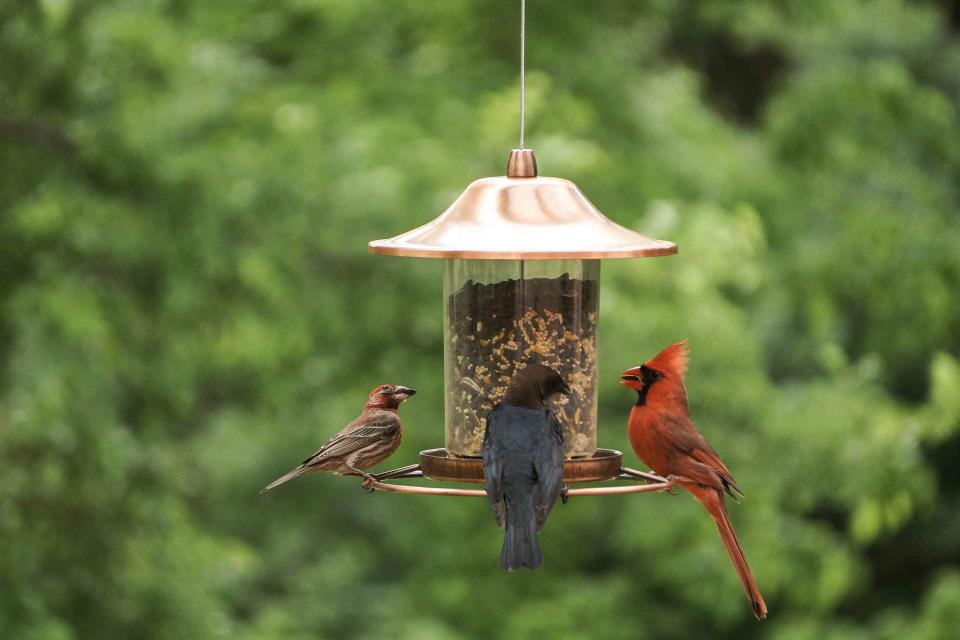The Right Way to Clean a Bird Feeder, According to an Ornithologist
Bird feeders can harbor bacteria and diseases if not properly cleaned on a regular basis.

Suma Hegde / Getty Images
Having a bird feeder in your backyard offers so many benefits—feeders can help birds survive harsh winters and migration while also offering you a way to connect with nature without leaving your home. Because bird feeders live outside, cleaning them may be an afterthought. However, not properly cleaning your bird feeder may unintentionally spread germs that can result in deadly illnesses for your flying friends, according to the U.S. Fish and Wildlife Service.
"Regular bird feeder cleaning is crucial to maintaining a healthy feeding environment as it minimizes the likelihood of disease outbreaks among the birds visiting your outdoor space," says Chad Witko, an ornithologist who is the senior coordinator of avian biology for the National Audubon Society’s Migratory Bird Initiative.
Ahead, Witko shares step-by-step instructions for cleaning your feeder. It won't take long and can help keep your backyard visitors safer.
Meet Our Expert
Chad Witko, senior coordinator of avian biology for the National Audubon Society’s Migratory Bird Initiative
Related: The Right Way to Clean a Bird Bath
How Often to Clean Your Bird Feeder
The frequency with which you clean your bird feeder varies depending on the type of structure you have. According to Witko, a seed feeder, one of the more common varieties, should be cleaned every two weeks, but you may want to clean them more often in hot or humid weather to prevent bacteria growth.
Suet feeders, a style that allows birds to nip at a solid piece of food, should be cleaned with each refill, while hummingbird feeders require cleaning every few days since they contain a sugar solution that can quickly turn moldy. "Under particularly hot conditions, they should be cleaned daily and the nectar fully replaced," says Witko. "Clean immediately if the nectar is cloudy, regardless of how long it has been."
Related: 14 Things You Should Never Put in Bird Feeders, According to Experts
Materials You Need
Before you begin, gather the necessary cleaning materials and tools. Your cleaning solution may vary, though, depending on the type of feeder you have. While a diluted bleach solution is great for seed or suet bird feeders, avoid using it if you have a hummingbird feeder. Hummingbird feeders should generally be washed with water only, but you can include vinegar in your solution for a deeper clean. Also, avoid using dish soap as it can leave harmful residue in the feeders, according to Witko.
For a seed or suet bird feeder, here’s what you need:
Mild soap or bleach
Water
Sponge or bottle brush
Gloves
For a hummingbird feeder, here’s what you need:
Vinegar
Water
Sponge or bottle brush
Gloves
Tips
It’s important to wear gloves when cleaning feeders since they have been exposed to wild animals.
Related: How to Attract Birds to Your Birdhouse—and Keep Other Critters Away
How to Clean Your Bird Feeder
Follow these instructions to keep your bird feeder safe for visitors.
Empty the Bird Feeder
Before you begin cleaning, make sure the bird feeder is empty of any seeds or nectar so you can scrub as thoroughly as possible. Don’t forget to wear those gloves!
Create Your Cleaning Solution
For a seed or suet feeder, mix 9 parts water to 1 part bleach, according to Witko. For hummingbird feeders, just water will do the trick, or you can mix a solution that is half water and half vinegar for a deeper clean.
Dismantle and Clean
Now, take your feeder apart carefully. Using your sponge (or bottle brush if your feeder is more of a tube-like shape) and cleaning solution, gently scrub each part of the feeder well, taking care to get into all the nooks and crannies.
Rinse and Dry
Rinse your feeder thoroughly with clean water and allow it to air dry completely before refilling it with seeds or nectar to prevent bacterial growth.
Related: Why Birds Fly Into Windows—and How to Prevent It From Happening
Read the original article on Martha Stewart.

